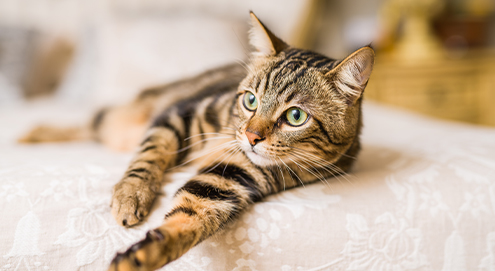Fleas in cats
Fleas are small blood-sucking parasites that can cause health issues in our cats. Think of itching and baldness. Fleas can also transmit diseases or other parasites. Most of the fleas (larvae, eggs, pupae) are in the environment and not on your cat itself. It is therefore important to treat your home against fleas and not just focus on the adult fleas on your cat.

Fleas can cause a lot of discomfort. The Vetsend Flea and Tick Guide has useful tips and helps keep track of when you need to give your pet tick and flea treatment.
Which fleas are found on cats?
There are dog fleas and cat fleas. The cat flea is most common in pets.
What does the life cycle of a flea look like?
Adult fleas live on a host and need blood to lay eggs. The largest part of the flea’s life cycle takes place in the environment. The flea eggs fall to the ground, where they develop further. The eggs hatch after 2-10 days. Larvae are a few mm long and feed on house dust, other larvae and flea droppings. They pupate after moulting 2 times. These cocoons can survive for months. When a host (dog or cat, but also people!) comes near, the young fleas hatch and jump on the host where the cycle starts again. The cycle lasts 2 weeks under optimal conditions. This means that a flea infestation can quickly develop.
Note: only 1-10% of the flea population consists of adult fleas (on your cat). More than 90% of fleas are eggs, larvae and pupae (in the environment)!
How can my cat become infected with fleas?
A cat can become infected when he is passing through places where many fleas occur. After that, an infected cat can infect other pets. The eggs from the environment can also stick to your shoes or pet and thus cause a new infestation.
What issues does my cat get from fleas?
Your cat mainly gets itchy from fleas. This is not always clearly visible. Sometimes this is limited to some scratching. Other cats get inflamed skin with scabs. We see this especially in cats that are allergic to fleas. This causes a lot of small inflammations in the skin. You see these inflammations mainly on the back and tail base of your cat. Kittens can become anaemic when it suffers from a heavy flea infestation.
In addition to the issues that the fleas themselves cause in your cat, fleas can also cause them to become infected with tapeworm. Fleas eat tapeworm eggs. A cat can then become infected by licking an infected flea while biting and washing. In addition, fleas can also transmit cat-scratch disease (dangerous for humans).
How do you recognize fleas on cats?
Fleas are not always easy to find, especially if your cat only has a few fleas and is not allergic. The preferred locations for fleas are your cat’s armpits, groin, and tail base. You can sometimes find fleas by combing your cat with a special flea comb. Sometimes you will find black dots in the comb or on the ground with this combing. This could be flea droppings. If you put these black dots on a damp, white tissue and they give off a brown-red colour to the tissue, then they are flea droppings, consisting of digested blood.
What to do against fleas in cats?
Treat your pet with anti-flea products. This can be done with a flea pipette or band from brands like Advantage, Frontline and Seresto. Choose a product that has something which stops the growth of other insects, so that eggs and larvae are also killed. Especially if your cat already has fleas. Treat your house the moment your pet has fleas. This can be done with an environmental spray that fights the immature stages of the flea and the adult fleas as soon as they emerge from the pupal stage.
Note: products for dogs are often not suitable for cats and vice versa!
In addition to products with insecticidal substances, there are also products with natural substances to which a flea repellent effect is attributed. No studies on the safety and efficacy of these products have been performed. That is why these products are often not registered as anti-flea products. Also, note that some natural substances can be toxic to your cat.
Always read the package leaflet carefully before using a product on your cat.
Do you have any questions about fleas on your pet and the best way to prevent or treat them? Then download our Step-by-step guide for Fleas where all the steps are clearly listed. Our vet is also happy to help you. Send an email to veterinarian@vetsend.co.uk or call our customer service.


